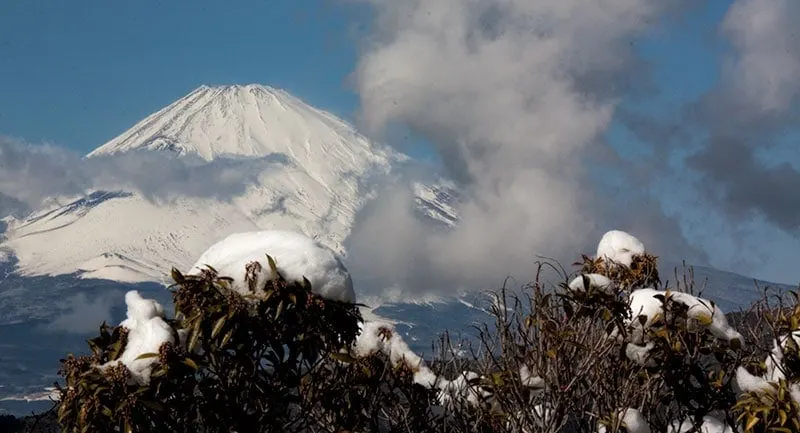
We decided that a Hakone day trip had to be included on our winter visit when we woke up one morning in Tokyo, flung open the curtains of our room at the Hotel New Otani and were greeted with an amazing view of Mt Fuji in the distance set against a clear blue sky. A few days later on another super clear morning, we jumped on an early bullet train and half an hour later we were in Odawara. We stopped into the information centre and picked up the ‘Hakone Free Pass’ and were on our way.
This pass was great value for us and there are a couple of versions to suit your travel needs. If you don’t have the JR Pass you can get the version that starts at Shinjuku in Tokyo, otherwise, jump on the Shinkansen to Odawara at Tokyo or Shinagawa stations and you’ll get there faster and save a few dollars.
The base pass is for 2 days but it’s still great value for a day trip, then there’s a 3-day version if you’re staying a couple of nights. The ticket we purchased was Y4000 (just over $43 Australian dollars). It covers all the transport you’ll need, the Tozan train and the cable car, the Hakone ropeway, a sightseeing cruise on Lake Ashi and a variety of buses between locations too. You can use all of them multiple times and in either direction. You also get discounts from dozens of museums, restaurants, onsen and other attractions by showing the pass.
>> Check latest prices for the Japan Rail Pass <<
We have another article on the site to give more information and to help you decide whether the Hakone Freepass is good value and if it might work well for you.
The variety of transport on this circuit and the amazing views they provide are a big part of this trip. We did the course anti-clockwise and if we did it again we would probably have doubled back after exploring the attractions at the southern end of the lake to enjoy the ropeway a second time. The bus was a faster way back to Odawara from Motohakone-ko but didn’t add much to the trip for us but we loved the ropeway and our time up the mountain.
>> Reviews and deals for the Hakone Freepass <<
Table of Contents
Hakone Tozan Train
We arrived at Odawara station on the Shinkansen but other JR local trains will get you to here too. We then took the Tozan train on the Odakyu line through to Gora. It’s a pretty standard older style train but very clean and comfortable as you come to expect in Japan. There are plenty of windows and we sat on the left-hand side which gave some gorgeous views as it meandered along its 40-minute route.
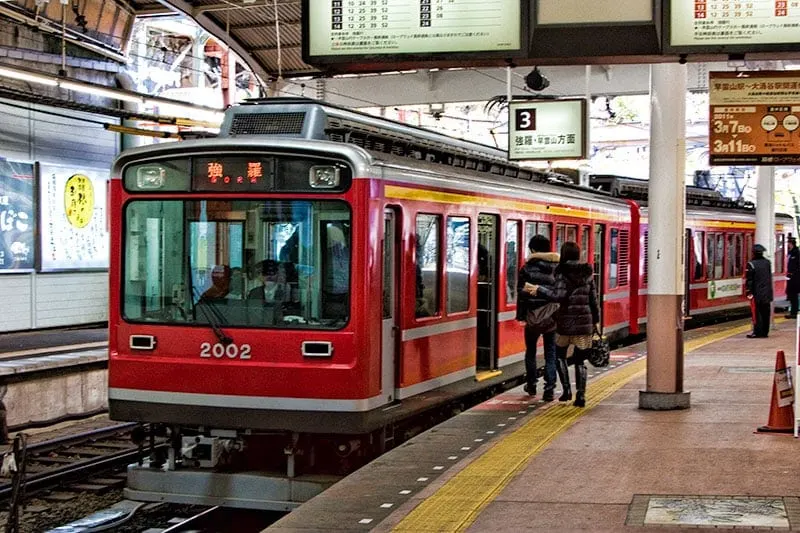
The train is built to climb the steep mountain slopes through the heavily planted area and over the 43-metre high Deyama Bridge. We’ve now been back through here in the autumn and I can imagine this route would be stunning in all seasons.
How gorgeous is the snow! Probably not so much if you live with it all the time but for someone from the sub-tropics it is a real highlight and had my camera out constantly. I had expected snow up the top of the rope-way but seeing it along the route was a definite bonus. The clear blue winter sky really made it extra special.
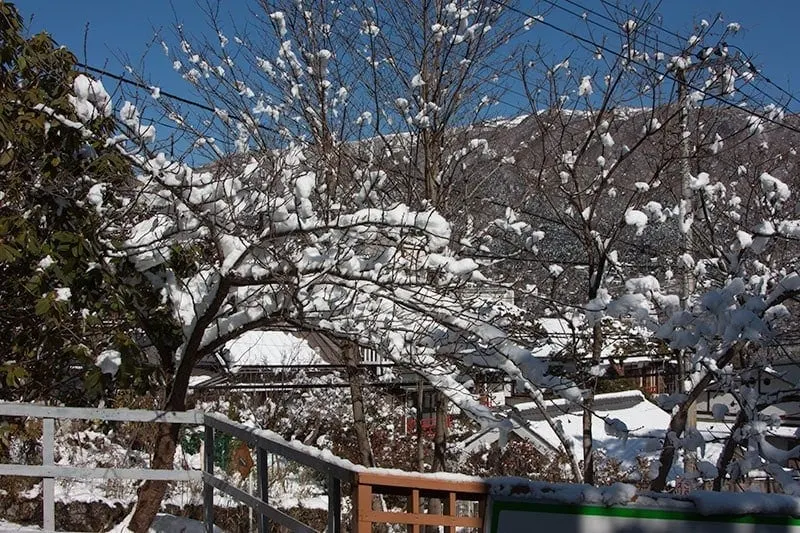
Hakone-Yumoto station is a popular stop on the Tozan Train route. This is the starting point if you arrive on the Odakyu Romance Car from Shinjuku or about a 15-minute ride from Odawara if you arrived by Shinkansen or other JR train. It’s an adorable little town with some good restaurants along the main street.
You can follow the river to the Tamadare waterfall and Shogenji Temple or do an onsen experience at Hakone Yuryo as we did if you can fit it into your day. Either start here or end your day with a relaxing soak and dinner.
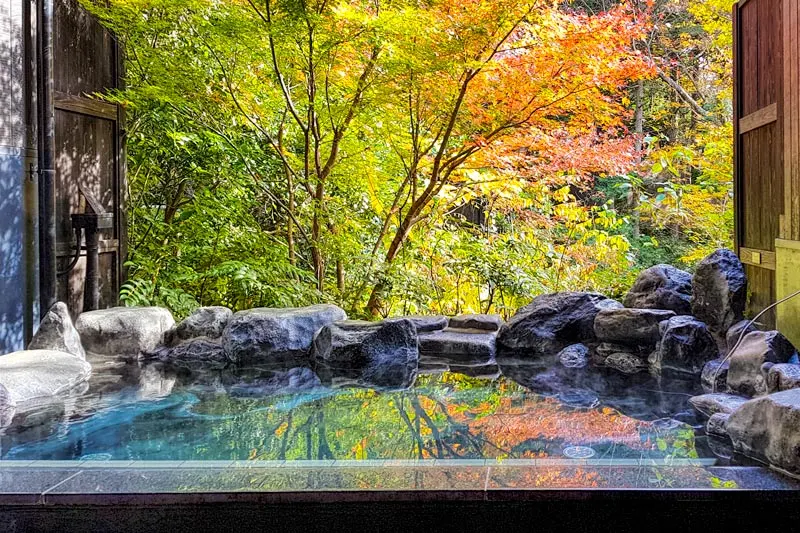
If you want to visit the Hakone open air museum, an outdoor art gallery and park then that is accessed along this route from the Tozan train. We visited it on a separate autumn visit and have included all the details you need and a load of photos to give you an idea of what to expect in the link.
Hakone Tozan Cable Car
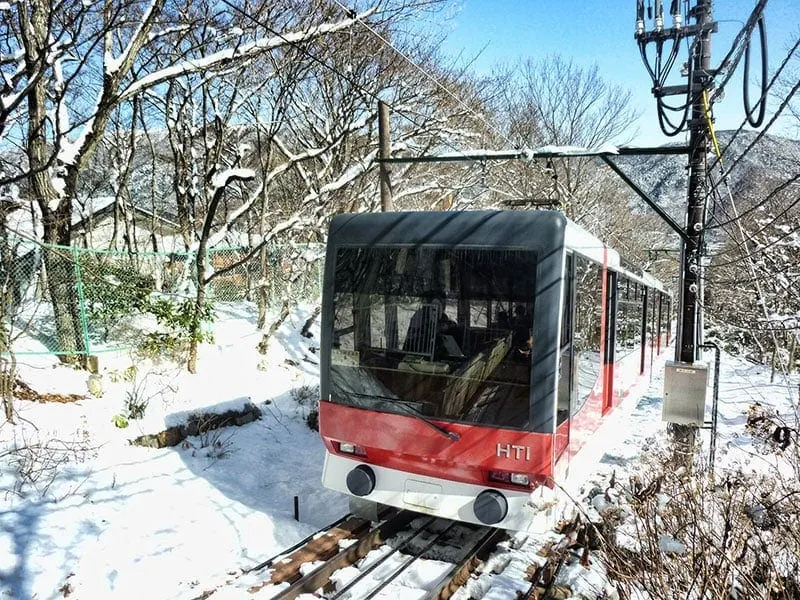
From the train station in the onsen town of Gora you walk to the adjacent cable car station. It looked a pretty town and I’d have liked more time in our schedule to explore a little on foot. Once on the cable car, it’s only a 10-minute ride up the hill and the views along the way are stunning, make sure you get a seat by one of the huge windows. Then at the top of the cable car is the first rope-way station.
Hakone Ropeway
The ropeway was amazing, each carriage has huge windows that provide amazing views of the mountain and the valley below. The full ropeway from Sounzan to Lake Ashi takes 30 minutes but you’ll want to get off in the middle to explore Owakudani.
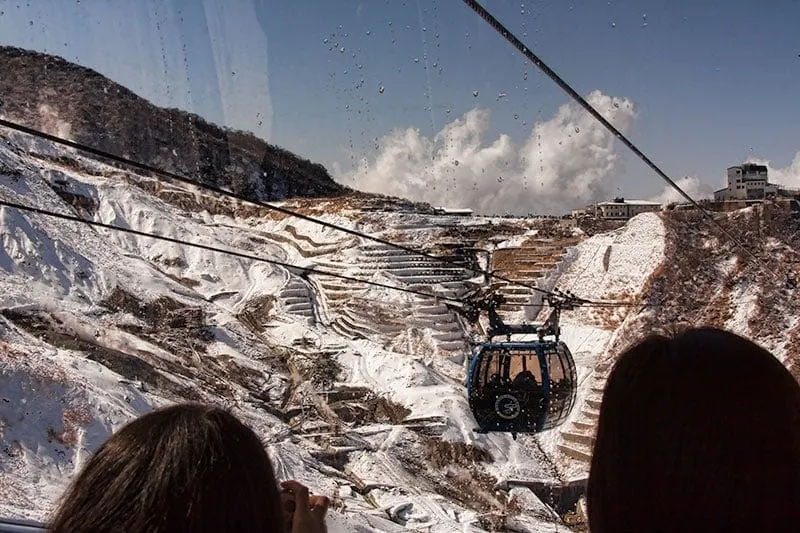
Owakudani
Three thousand years ago Mount Hakone erupted leaving a crater that is known today as Owakudani. The area remains an active volcanic region with hot rivers and springs and the ever-present smell from the sulphur fumes. It’s sometimes called Hell Valley which may be a throwback to the name O-Jigoku meaning ‘great hell’ which the area was known as around 150 years ago.
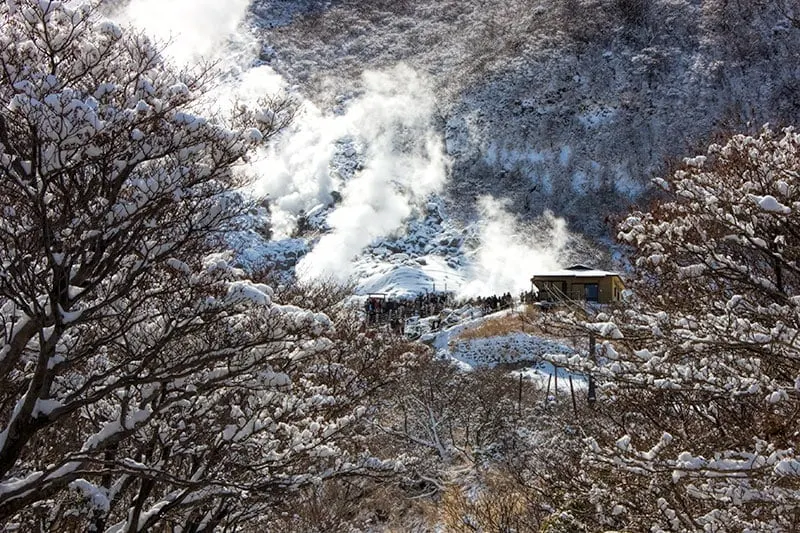
You can walk up to see the kuro-tamago (black eggs) being boiled in the natural springs, the minerals turn the shell black but inside it still looks like a normal boiled egg. Legend says eating one will extend your life 7 years but I couldn’t bring myself to do it, I hate everything about boiled eggs. There are plenty of weird and wonderful things I’ll eat on my travels but a boiled egg, well heck no! The legend also says you should eat no more than 2 so don’t go trying to make yourself immortal.
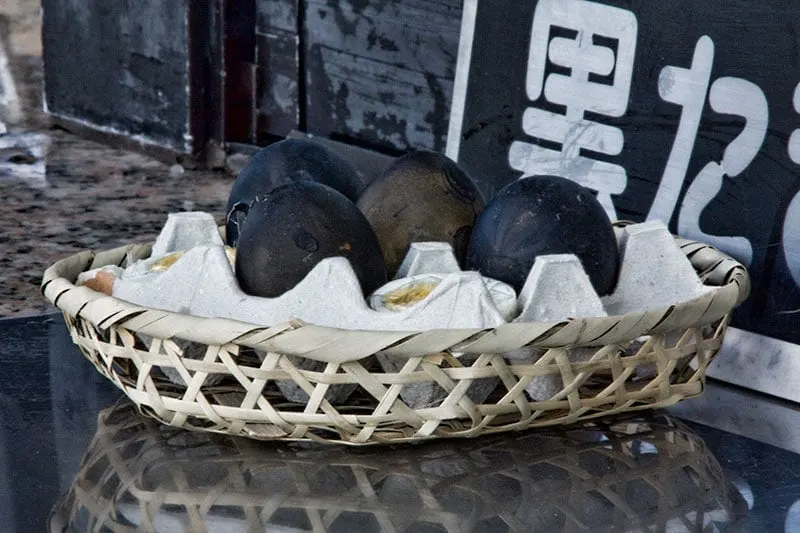
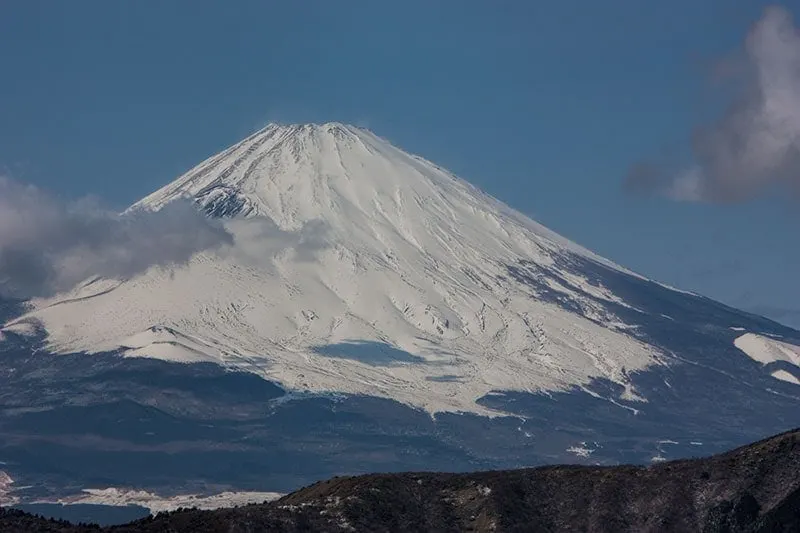
The view of Mt Fuji was unbelievably good from up here but I believe it does depend on the day. If you can pick a clear one it’s best, on a bad day Fuji-san might be off hiding in the clouds and you’ll never know it’s there.
I also loved this small Buddhist alter near the entrance to the walk up to the hot springs. The Buddhist monk Kobo Daishi who founded the Shingon sect in Japan visited this spot 1000 years ago, he prayed for those suffering in the hell realms and placed a statue of the Bodhisattva Jizo. Today the Enmei Jizouson Temple stands here.
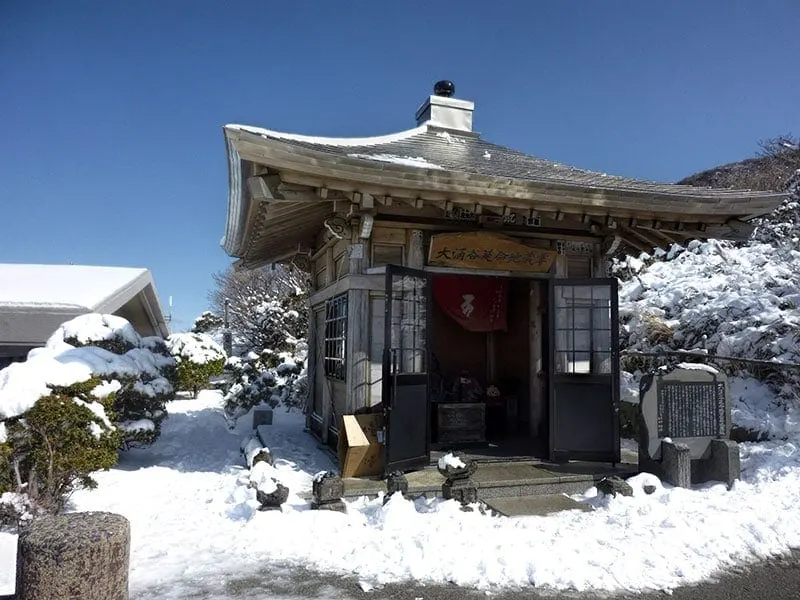
Hakone Sightseeing Cruise
From Togendai the pirate boat cruises the length of Lake Ashi to Moto-Hakone-Ko. The views of Mt Fuji are also pretty stunning from the lake but the day was starting to cloud over as the afternoon progressed. I would imagine in other seasons the hillsides would be really pretty but with just a dusting of winter snow, they were quite brown and bare.
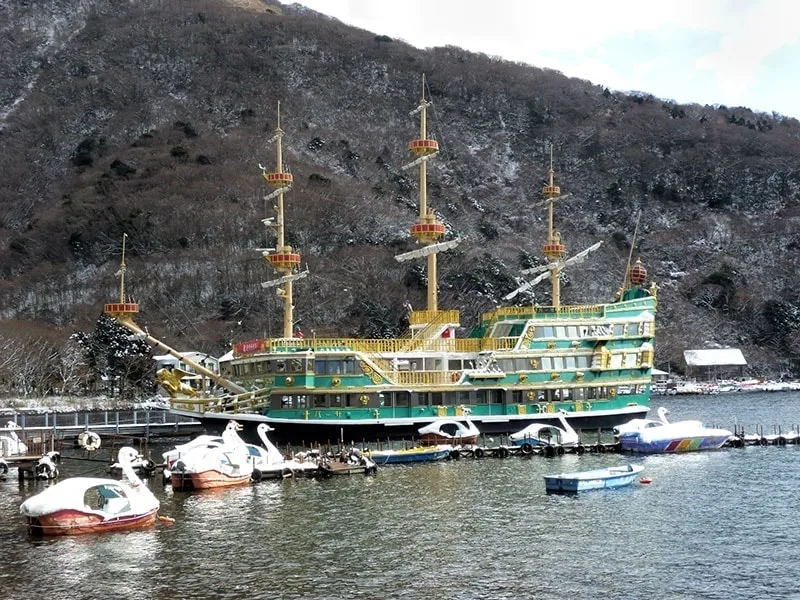
Hakone Checkpoint
At the southern end of Lake Ashi is the Hakone Checkpoint. During the Edo period, this was an important checkpoint on the Tokaido highway that linked Tokyo and Kyoto. Recent work has restored it to a structure consistent with that time with gates, fencing, a lookout, prison and housing as it would have been for the officers and soldiers during that time.
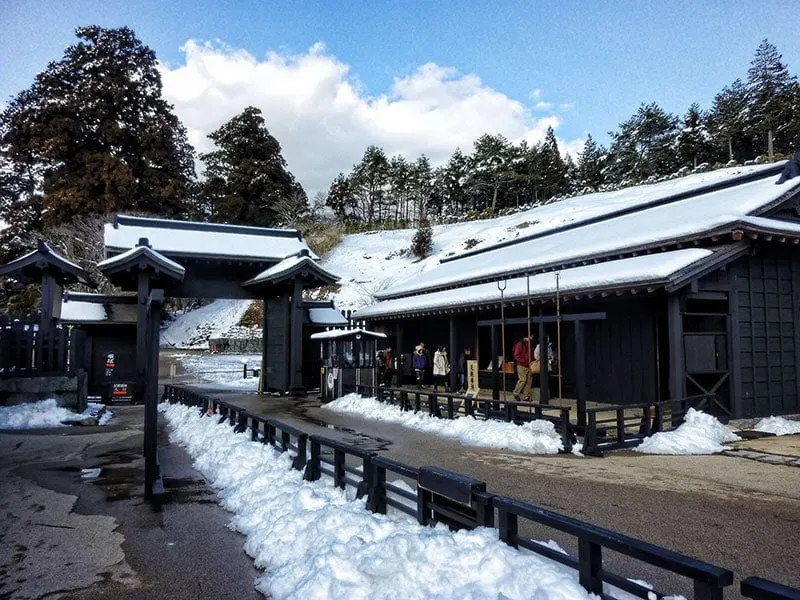
Also further on from here is the cedar walk, a segment of the old Tokaido highway. There was a good covering of snow on the ground so it wasn’t possible to tell on the day we went but I believe some of the original highway stone paving is visible here during most of the year.
A bit further on again you’ll come to the Hakone Jinja (Shinto shrine). It’s set into the forest but you’ll see the torii gates as you approach from the Moto-Hakone road. Once inside walk down to the lake and you’ll see a ‘floating’ torii, it’s much smaller but a similar concept to the one at Miyajima island.
We pretty much called it a day from here and headed back using the local bus service which was also covered by the pass. With a day trip during the short days of winter, it was difficult to fit much more in. We are slow travellers, love a bit of a detour and did spend longer than we planned at Owakudani. We decided to stop for lunch up the top of the mountain there as the views out to Mt Fuji were just so good.
We went back on another trip to visit the Hakone Open Air Museum (art gallery) as we ran out of time to loop back as we planned to at the end of the day. Also an overnight trip would allow you to make use of the hot spring onsens that the area is renowned for, several of the hotels have these available for guests. I’ve shared information on our Hakone Onsen experience and it is practical to add this and dinner to the end of your day’s sightseeing even if you’re returning to Tokyo or on to Kyoto.
There’s free Wifi too!
You might have noticed that free Wifi isn’t as easily available in Japan as it is in many western countries. This had been a surprise to me given how technologically advanced Japan is. There are personal wifi options for travellers and some free connections available if you know where to look. We now choose to carry personal WIFI that works across our phones, tablets and computer across Japan. This WIFI service is a good option for many travellers and can be quickly collected from the airport when you arrive and dropped back as you leave
If you choose to use the free options when they are available then the Hakone day trip will make it a little easier for you to look up information or share those gorgeous pictures of your day on Instagram during the day using the Odakyu Free Wifi. There are blue signs with the international wifi symbol showing where it’s available but it’s at the various stations, ports and on the boat as you go around the course.
Looking for a way to do Mt Fuji and Hakone in one day?
Travelling independently our experience is that Hakone and Mt Fuji require a minimum of a day each in order to see enough to really enjoy it. Sometimes though time is really limited and you just don’t know when you will have the chance to be back.
If that’s the case then there is a recommended tour option that includes the highlights of both Mt Fuji and Hakone. The tour picks you up from a variety of locations in Tokyo, you make the trip up to Mt Fuji’s 5th station for its incredible views, cruise in on Lake Ashi, and ride the ropeway taking in the unique perspective on stunning views of Hakone and Mt Fuji. The tour includes lunch and transfers back to Tokyo.
Additional Information for Planning your trip to Hakone
We have a few extra resources to help you plan your trip to Hakone.
- Our route and an assessment of when the Hakone Free Pass is good value
- Our experience at a traditional onsen in Hakone during the autumn season
- Tips for planning your trip to see the outdoor art display at the Hakone Open Air Museum
- The tips you need to get the most out of the transport system in Japan
- Our Japan Guide linking you up with all the information, tips and suggestions you need to know
Have you visited the Hakone area either on a day trip or longer stay? If you have a moment please leave a comment below to share your thoughts on your experience and your favourite spots in the area.
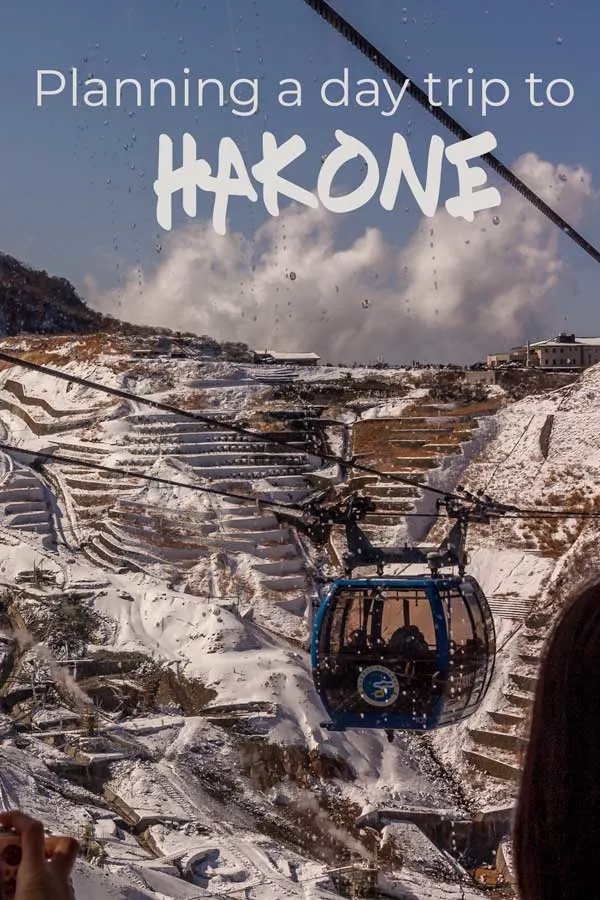
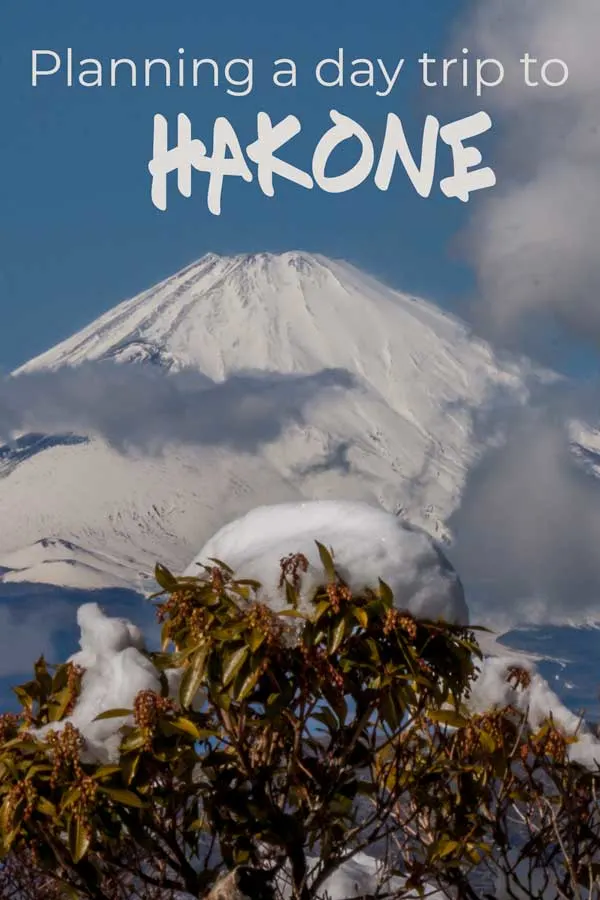
Vivian
Saturday 18th of January 2020
Hello 2AT, thank you so much for your great posts! I will be traveling with my husband and 2 sons, ages 24 and 18 to Japan during the 2020 Olympics. We want to take one of the days from Tokyo to do a day trip to Hakone. Obviously, we anticipate big crowds. We think the Hakone Free Pass is the best choice, even though we will only be there one day and return to Tokyo in the evening. What happens if the trains are full? Do we catch the next one? Also, where is the absolute best view of Mt. Fuji? That is our main objective, since we will not have much time there. I appreciate your feedback. Vivian
Toni Broome
Saturday 18th of January 2020
Hi Vivian, I think you are right that it will be very busy during the Olympics but it's much harder to predict how that will impact outside Tokyo than normal seasonal peaks. I would pre-book the romance-car or another train between Tokyo and Odawara/Hakone that way you know you are going to get there and back on your own timetable. The Hakone transport on the loop using the pass is just a case of waiting for the next one if it is full, it's less of an issue on the trains and buses but there is often a bit of a queue as they are loading up the cable car (due to be reopened in March after the typhoon damage) and at the ropeway stations but it moves quite quickly.
There are many places to view Fuji but all of them depend on the day and with the Olympics being in summer that is less likely to be a clear day although it changes frequently, our best view was from Owakudani near the geothermal area at the top of the ropeway but when we arrived it wasn't visible due to clouds, when they cleared just a few minutes later it was a stunning from up there. On Lake Ashi and from the shores around the lake is another top spot. Both are on the circuit with the Hakone Freepass.
IFTEKHAR I ASIF
Thursday 26th of December 2019
Thanks for the post. I am going on a day trip this new year's vacation. I will follow this blog.
Anyway, I have a question. If I take a 2-day pass & come back to Shinjuku that day, then can I use the same pass the next day? I am not getting this information anywhere. So, if you know please let me know before 30th December. Thanks!
Toni Broome
Thursday 26th of December 2019
At this stage (December 2019) the Tozan Cablecar is not operating due to damage to the track that occurred during a major typhoon in the late summer. Odakyu are operating an alternative bus between Gora station and Sounzan Station. This is expected to continue until late March 2020. The bus fare is included in the Hakone Freepass. Changes to services can be seen on the official site.
Toni Broome
Thursday 26th of December 2019
The 2-day pass includes 2 days of transport in the Hakone area but one return trip to Tokyo.
Travel in pictures
Thursday 5th of September 2019
Thanks for sharing. We went to Japan with the kids and it was amazing.
Viv
Tuesday 2nd of April 2019
Hi, Great post!! We are visiting Japan next week and will have a JR pass. Does this cover all the transport options you mention in your day trip? Thanks viv
Toni Broome
Tuesday 2nd of April 2019
Hi Viv. The JR Pass covers very little of Hakone. JR or Japan Railways is the National train company and operate most of the intercity routes and bullet trains in addition to some routes in city areas. There are also many smaller railway companies that cover smaller areas and provide commuter and/or tourist services in those areas. In Hakone that is Odakyu which is why their 'Hakone Free Pass' can be a good option for visiting here and saving money if you are doing the loop or moving around quite a bit. With your JR pass you will probably want to take the bullet train as far as Odawara (the JR Hakone stop) but from there will need individual tickets or the Hakone Free Pass. Odawara is a hub station, both JR and Odakyu use it. I'll link another article that shows a value calculation on the pass, this was based mostly on one of our first trips there where we also use the JR pass as far as Odawara.
Veena
Thursday 7th of March 2019
Hi, This article and the Hakone Freepass value was extremely informative. It has helped me plan my Hakone itinerary very well. I have one doubt though - All through your Hakone trip(Odawara-Gora-Sounsan-Togendai circuit), you do not mention the Fuji 5th station. Is this a deviation? I would like to include this also in the aforesaid circuit. Can you advise please?
Toni Broome
Thursday 7th of March 2019
While you can see Fuji really well from points around the circuit you aren't actually that close to it so it doesn't form part of the Hakone circuit. If you were going to do both destinations in a couple of days the Fuji Hakone Pass would be better than the Hakone free pass for that. By preference, if doing it independently I'd go directly from Tokyo to Kawaguchiko then take the bus from outside the train station (just under an hour) to the Fuji 5th station.